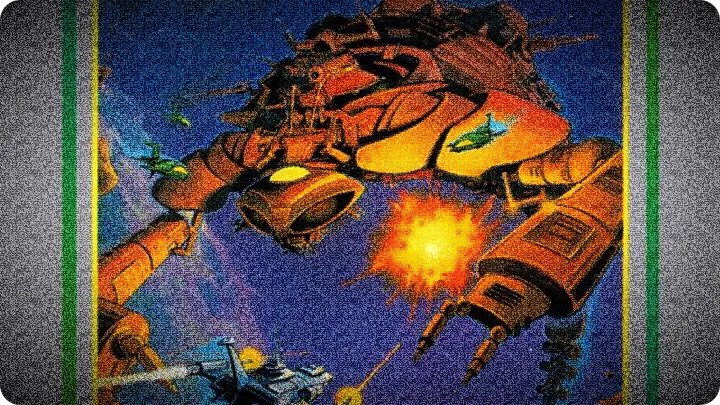 fun fact: SNK, the company behind Alpha Mission, began as Shin Nihon Kikaku in the late 1970s. By the mid-1980s, they were quietly producing arcade hardware and shooters favored by arcade owners. They were a small but focused developer, the kind that let you hear the wiring hum inside a cabinet. That same no-nonsense design shows up in Alpha Mission’s tight, mechanical feel.
fun fact: SNK, the company behind Alpha Mission, began as Shin Nihon Kikaku in the late 1970s. By the mid-1980s, they were quietly producing arcade hardware and shooters favored by arcade owners. They were a small but focused developer, the kind that let you hear the wiring hum inside a cabinet. That same no-nonsense design shows up in Alpha Mission’s tight, mechanical feel.
First Impressions
 The CRT hums and the cartridge smells faintly of nostalgia. Stage one begins with the score counter alive and enemies already routing into formation. Controls feel crisp: joystick up to move, button one to shoot forward, button two to bomb ground targets. Syd’s little sprite cuts cleanly through the first wave.
The CRT hums and the cartridge smells faintly of nostalgia. Stage one begins with the score counter alive and enemies already routing into formation. Controls feel crisp: joystick up to move, button one to shoot forward, button two to bomb ground targets. Syd’s little sprite cuts cleanly through the first wave.
 Air and ground attacks are separated, which I like. Dropping a bomb right under a walker feels great. The game scrolls upward without pause, leaving no time to think — only reflexes. A glowing capsule boosts our firepower from a single shot to a wider spread. The power-up system is practical, with no wasted frills.
Air and ground attacks are separated, which I like. Dropping a bomb right under a walker feels great. The game scrolls upward without pause, leaving no time to think — only reflexes. A glowing capsule boosts our firepower from a single shot to a wider spread. The power-up system is practical, with no wasted frills.
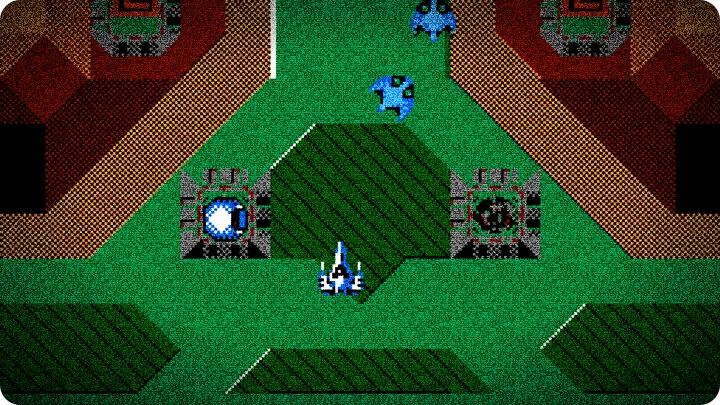
Gameplay Highlights
 The core loop is straightforward and reliable: survive the stream of enemy fighters, bomb the ground emplacements, and snag the power-ups that let Syd transform into a heavier, meaner configuration. The transformation mechanic is a neat touch. When we gather several energy pods, Syd becomes a meaty craft with stronger forward fire and a secondary rear weapon. It gives real moments of escalation that feel earned rather than arbitrary.
The core loop is straightforward and reliable: survive the stream of enemy fighters, bomb the ground emplacements, and snag the power-ups that let Syd transform into a heavier, meaner configuration. The transformation mechanic is a neat touch. When we gather several energy pods, Syd becomes a meaty craft with stronger forward fire and a secondary rear weapon. It gives real moments of escalation that feel earned rather than arbitrary.
 Enemy formations are deliberate. They feel designed to test pattern recognition rather than rely purely on cheap hits. Bosses, when they arrive, present clear attack telegraphs you can learn. The arcade-style pacing — ample enemies and short but tense stages — is great for quick sessions between chores or during a quarter-eating marathon.
Enemy formations are deliberate. They feel designed to test pattern recognition rather than rely purely on cheap hits. Bosses, when they arrive, present clear attack telegraphs you can learn. The arcade-style pacing — ample enemies and short but tense stages — is great for quick sessions between chores or during a quarter-eating marathon.
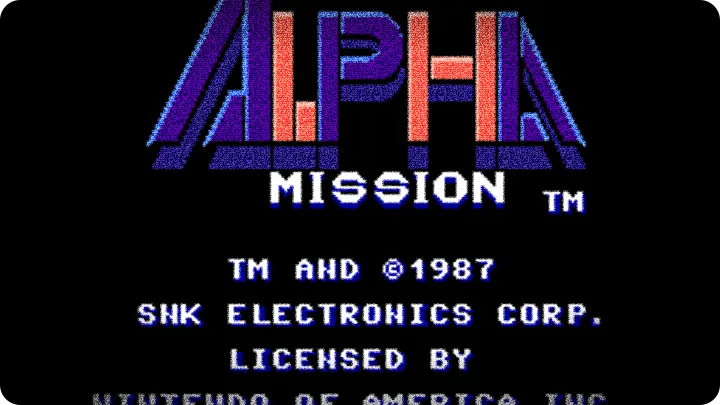
Hot Tips
- Conserve your bombs for concentrated ground clusters or for slicing open a boss’s weak vent; using them randomly wastes their value.
- When Syd transforms for increased firepower, you move a touch slower. Use the extra strength offensively, but resist hugging the bottom of the screen where enemies crowd.
- Memorize spawn lanes on the early waves; survival often comes down to sliding through the same narrow corridor three times in a row.
- Watch the background — terrain cues often herald ground turrets appearing where a bomb will be effective.
Memorable Moments & Anecdotes
 We hit mid-game and that chime plays as we collect the upgrade that changes Syd’s nose into double cannons. I feel the heavier shots punch through infantry and small fighters alike. There is a moment now — a stretch where everything aligns: we are in the transformed state, the screen is dense with enemies, and we thread through a narrow gap as a kamikaze fighter explodes on our tail. The cabinet’s speaker crackles and I grin; that risk-reward is pure arcade design.
We hit mid-game and that chime plays as we collect the upgrade that changes Syd’s nose into double cannons. I feel the heavier shots punch through infantry and small fighters alike. There is a moment now — a stretch where everything aligns: we are in the transformed state, the screen is dense with enemies, and we thread through a narrow gap as a kamikaze fighter explodes on our tail. The cabinet’s speaker crackles and I grin; that risk-reward is pure arcade design.
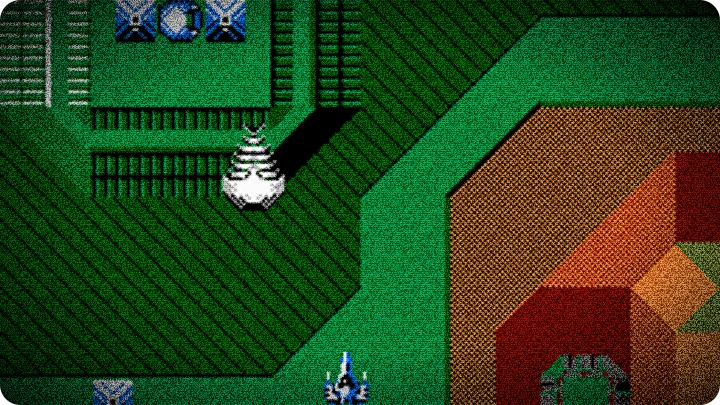
 A memorable beat is clearing a stage of ground targets and then, without respite, being swarmed by glider units that bank and release eggs. It forces you to switch focus from bombing to dodging in an instant. The small graphical touches — smoke columns where turrets were, and the flicker of a destroyed factory — sell the idea that our ship Syd is pushing a contested frontline to the limit. It is drama conveyed with modest pixels.
A memorable beat is clearing a stage of ground targets and then, without respite, being swarmed by glider units that bank and release eggs. It forces you to switch focus from bombing to dodging in an instant. The small graphical touches — smoke columns where turrets were, and the flicker of a destroyed factory — sell the idea that our ship Syd is pushing a contested frontline to the limit. It is drama conveyed with modest pixels.
 The final boss encounter on stage six is a quietly cinematic thing. It is a hulking fortress that rotates slowly, exposing different gun ports. Each rotation opens new windows of vulnerability and new streams of bullets. We alternate between bombing its lower hull and peppering the exposed cores with concentrated fire. It is less a solo dramatic showdown and more a sustained engineering problem: keep your momentum, manage power-ups, and target the exposed systems in sequence. When it finally breaks apart, the sprite debris tumbles and the fanfare plays; it is satisfying precisely because the game made victory a mechanical achievement rather than a fluke.
The final boss encounter on stage six is a quietly cinematic thing. It is a hulking fortress that rotates slowly, exposing different gun ports. Each rotation opens new windows of vulnerability and new streams of bullets. We alternate between bombing its lower hull and peppering the exposed cores with concentrated fire. It is less a solo dramatic showdown and more a sustained engineering problem: keep your momentum, manage power-ups, and target the exposed systems in sequence. When it finally breaks apart, the sprite debris tumbles and the fanfare plays; it is satisfying precisely because the game made victory a mechanical achievement rather than a fluke.
Balance and Critique
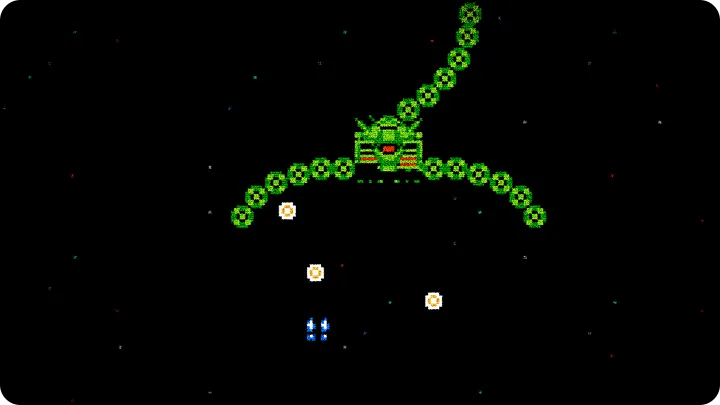
 Now, to be candid — and we are giving this a fair assessment — Alpha Mission has rough edges. The difficulty curve can spike suddenly; a wave can feel impossibly dense if you are underpowered. The enemy bullets are sometimes pixel-perfect in their hit detection, which makes close calls feel unforgiving rather than skill-testing. Progression depends heavily on obtaining and keeping power-ups; when you die you often revert to a very weak state that makes recovery a slow slog.
Now, to be candid — and we are giving this a fair assessment — Alpha Mission has rough edges. The difficulty curve can spike suddenly; a wave can feel impossibly dense if you are underpowered. The enemy bullets are sometimes pixel-perfect in their hit detection, which makes close calls feel unforgiving rather than skill-testing. Progression depends heavily on obtaining and keeping power-ups; when you die you often revert to a very weak state that makes recovery a slow slog.
 The presentation is competent but conservative. The soundtrack is functional, with chiptune hooks that do their job without sticking in your head for days. Background art is serviceable, though stages can blur together after a few rounds. Controls are generally tight, but the limited lives and the occasional cheap spawn at the bottom of the screen can punish a single small error with a rapid chain of losses.
The presentation is competent but conservative. The soundtrack is functional, with chiptune hooks that do their job without sticking in your head for days. Background art is serviceable, though stages can blur together after a few rounds. Controls are generally tight, but the limited lives and the occasional cheap spawn at the bottom of the screen can punish a single small error with a rapid chain of losses.
Final Thoughts
 In short, we are enjoying our time with Alpha Mission right now — the pacing, the weapon upgrades, and the bombing mechanic make for honest arcade fun. At the same time, the occasional frustration of difficulty spikes and the less-distinct presentation keep it from being a standout classic. For players who enjoy methodical pattern learning and the satisfaction of incremental upgrades, it is a worthy pick. For those who demand a more forgiving progression or flashier presentation, it will show its age.
In short, we are enjoying our time with Alpha Mission right now — the pacing, the weapon upgrades, and the bombing mechanic make for honest arcade fun. At the same time, the occasional frustration of difficulty spikes and the less-distinct presentation keep it from being a standout classic. For players who enjoy methodical pattern learning and the satisfaction of incremental upgrades, it is a worthy pick. For those who demand a more forgiving progression or flashier presentation, it will show its age.

 Final thought while the attract mode starts back up and we feed another quarter: Alpha Mission earns a C. It is a competent, often rewarding vertical shooter with a few stubborn rough spots. It is the kind of cartridge you keep around for the afternoons when you want something immediate and mechanically honest — and perhaps, like us, for the simple pleasure of hearing quarter slots clink and the CRT glow steady into the evening.
Final thought while the attract mode starts back up and we feed another quarter: Alpha Mission earns a C. It is a competent, often rewarding vertical shooter with a few stubborn rough spots. It is the kind of cartridge you keep around for the afternoons when you want something immediate and mechanically honest — and perhaps, like us, for the simple pleasure of hearing quarter slots clink and the CRT glow steady into the evening.
more info and data about Alpha Mission provided by mobyGames.com

